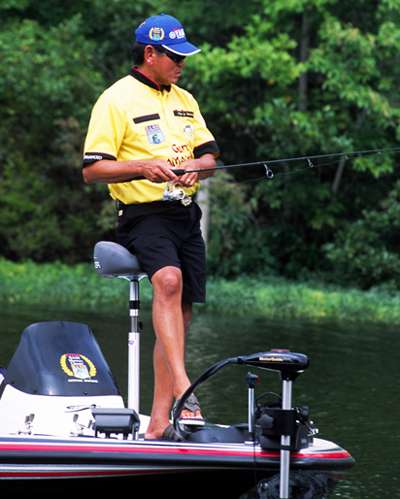
It looks rather nondescript while hanging on a hook, but submerge this lure in water and watch its seductive wiggling tail tempt even the most finicky bass into biting.
Back when the Slug-Go was the hot bait on the tournament trail, Gary Yamamoto tried the lure but thought it was too hard and bulky. After constant tinkering and whittling on a piece of plastic, Yamamoto designed a similar style of bait to his liking. He believes the softer plastic molded into the Senko and the way water flows around the lure as it falls makes the Senko an effective bait. "If you look at the subtleness of the bait as it falls on a weightless Texas rig, it has a continual vibration," he says.
The Senko has to be considered one of the simplest and most effective lures for catching bass today, yet some anglers have a tendency to overdo it with the lure despite its simplicity. They diminish the effectiveness of the Senko by matching the lure with tackle that is too heavy or by working the lure too fast. So BASS Insider asked the lure's inventor to share the following tips on how he fishes his creations.
While some anglers have success wacky rigging the Senko, Yamamoto prefers his Senko on a weightless Texas rig with a 3/0 Gamakatsu extra wide gap hook. "I think some people use too big of a hook because they are thinking the bigger hook they use the better chance they have of hooking the fish," says Yamamoto. "That does work at times, but then sometimes with a bigger hook they lose the action of the bait on the fall, and half the time they lose the bait because it tears off."
The lure designer believes smaller light-wire hooks increase the lure's tail action and make the Senko last longer since the bait slides easier up the hook and onto the line while fighting a fish. Yamamoto also recommends rigging the Senko on a Yamamoto Split Shot Hook, a circle hook that embeds in a fish's mouth by merely reeling after the bite. Tying the Senko with a Snell knot is another key to rigging the lure. Whereas other knots are tied to the hook eye and can slide back and forth on the eye, the Snell knot requires wrapping a loop around the hook so the line is secured to the hook instead. "I like that knot because when you tug on it, it will pull that hook barb straight toward the line," Yamamoto says.
For most situations, Yamamoto prefers a 5-inch Senko, but when fishing in gin-clear water he scales down to the 4-inch model. "When I am teaching people how to fish, I normally like to use a 4-inch Senko because it is lighter, easier to work with and easier to cast," he says. His favorite Senko colors are green pumpkin or green pumpkin and watermelon laminate. "One of the best colors that is probably a sleeper is the salt-and-pepper," he says. "I think it is a forgotten color, but I can take that color any place in the world and fish will bite it."
The Senko is ideal for casting to any targets since its slow fall keeps it in the strike zone longer and it is weedless when rigged Texas style. Yamamoto employs a simple lift-and-drop retrieve to tempt bass. "It's like working a plastic worm but not quite as fast because it takes longer for it to fall," he describes. Tackle
A 7-foot light-action spinning rod and a 2500 series spinning reel are Yamamoto's choices for working a Senko. He opts for high visibility 10- or 15-pound braid for his main line and ties on a Sugoi Fluorocarbon leader of 10- to 14-pound test for stained water or 6- to 10-pound test for clear water. Heed these tidbits from the lure's creator and that simple-looking Senko dangling on your hook will transform into a bass-catching beauty.





